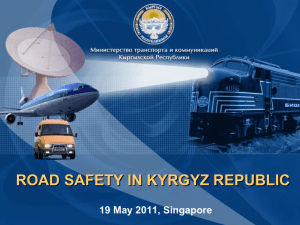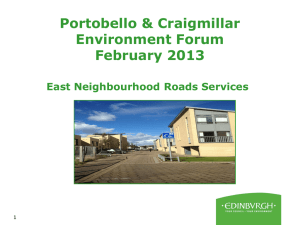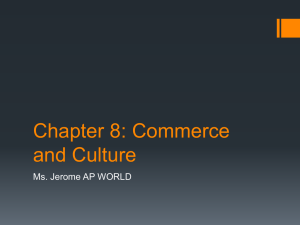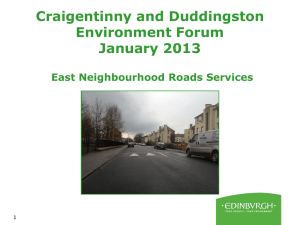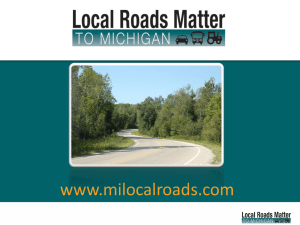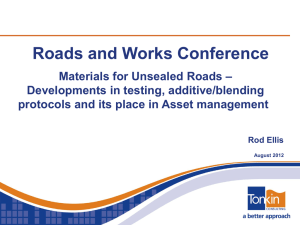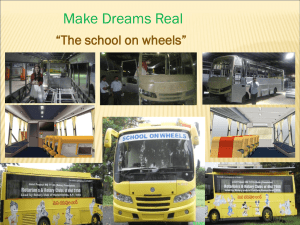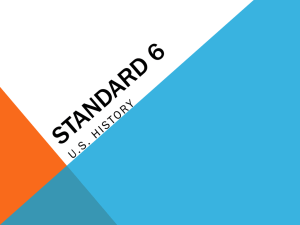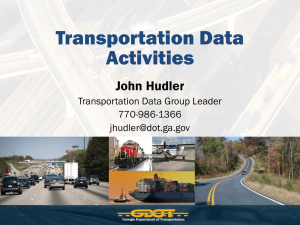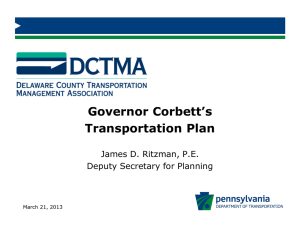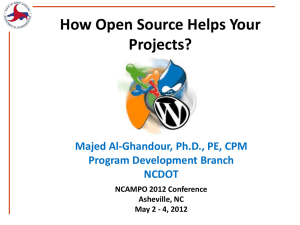to the Senate Transportation Funding Task Force, November 7
advertisement
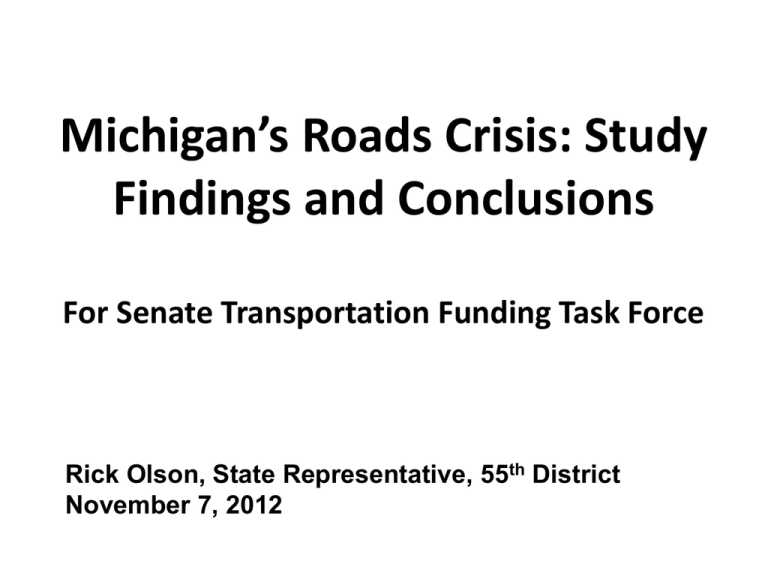
Michigan’s Roads Crisis: Study Findings and Conclusions For Senate Transportation Funding Task Force Rick Olson, State Representative, 55th District November 7, 2012 Overview of Presentation • Focus on: “How Much Additional Money Do We Need to Maintain our Roads and Bridges?” • Not: – How do we raise the money? – How do we distribute the money? – How we can get the greatest value for our money in road and bridge maintenance? – Are there benefits which exceed the costs? – How does Michigan rank in terms of cost and road quality compared with other states? Transportation Funding Task Force • Transportation Funding Task Force (TF2) created in response to Public Act 221 in Dec. 2007 • Issued final report to Legislature, Governor and State Transportation Commission on Nov. 10, 2008 • TF2: Double Investment - $3 Billion/Year Needed • Report available online: www.michigan.gov/tf2 Transportation Funding Work Group Reason: Skepticism about the TF2 recommendations. Task: Review previous studies, consult with various stakeholders, and make recommendation for the future funding needs of transportation. Objective: Recommend funding level needed to minimize the long term cost of maintaining our roads and bridges Technical Analysis Team • Gil Chesbro, MDOT Transportation Planning Specialist • Jim Ashman, MDOT Transportation Planner • Craig Newell, MDOT Manager, Statewide Systems Management Section • Denise Jackson, MDOT Administrator, Statewide Transportation Planning Division • Bill Tansil, MDOT Administrator, Asset Management Division • Kelly Bartlett, MDOT Legislative Liaison • Carmine Palombo, MI Asset Management Council • Bob Morris, SEMCOG • Steve Warren, MI Asset Management Council • Frank Raha, Michigan Transportation Commission How Much Money Do We Need? Using models from: • MDOT RQFS (Road Quality Forecasting System) • Asset Management Council (PASER data) (50,000’ level, not project specific like RoadSoft) • MDOT Bridge Forecasting model Database of the condition ratings of MI roads • Federal Aid roads – 100% • Non-federal Aid roads – 40% (assume representative of remaining 60%) Models contains • Deterioration rates of PASER condition • Improvement in PASER road condition with selected “fix” from X to Y additional road life for each “fix” How Much Money Do We Need? The model does not provide for additional money for: • Strategies to relieve congestion • Mega-type reconstructions, like the I-75 and I-94 reconstructions whose costs are in the $1.7 M range. • Reactions to address safety needs based on accident analysis • Additions to paved roads or increased attention to gravel roads • Local & State road agency equipment needs • Transit: light rail, bus systems Assumed current stream of money for these needs continues 2012 – 2016 MDOT Five-Year Transportation Plan Category Routine Maintenance Repair & Rebuild Roads Repair & Rebuild Bridges Capacity Improvement & New Roads Safety & System Operations Other Five-Year Total (millions) 1,343 2,151 962 385 638 520 5,999 How Much Money Do We Need? Goals: % Good or Fair: • Freeway: 95% • Remainder State Trunkline, Non-Freeway: 85% • Federal Aid, Non- State Trunkline : 85% • Non-federal Aid roads: 85% Goal: Select the combination and timing of fixes from the “mix of fixes” that costs the least long-term to maintain our asset value of our highway system – a business approach. How Much Money Do We Need? Assume Costs Per Lane Freeway Mile Through 2015 of: • Reconstruction - $1,456,000 • Rehabilitation - $643,000 • Capital Preventive Maintenance - $66,600 Similar assumptions for • Non-freeway state trunkline highway • Remainder of federal aid highways, non-state trunkline • Remainder of paved roads in state Assumes 5% inflation after 2015 Assumed Existing Revenue Continued stream: • Gas tax • Diesel fuel tax • Vehicle registration fees • Federal gas tax allocations - steady How Much Money Do We Need? Assume when you use each “Fix”, e.g., State Trunkline highways: 2012-2016 Reconstruction Rehabilitation Preventive Maintenance 2017-2023 Reconstruction Rehabilitation Preventive Maintenance Freeway Non-Freeway 1.13% 4.34% 5.50% 0.98% 3.09% 7.89% 1.13% 4.51% 4.91% 0.96% 3.09% 7.03% 2024 Reconstruction Rehabilitation Preventive Maintenance 2024-2028 Reconstruction Rehabilitation Preventive Maintenance 0.99% 3.10% 6.14% 2025-2028 1.51% 4.06% 5.27% 0.99% 2.91% 6.14% Strategy in Selecting Projects • Not enough funds to do all that needs doing • Seek to minimize long term cost of maintaining the roads via an “asset management” strategy • Prevent roads in “fair” condition from falling into “poor” category Strategy in Selecting Projects • Result when there are insufficient funds: roads in “poor” condition get in even worse shape • Reality: Pressures from people are responded to – “worst first” vs. “asset management” • Therefore, this model is optimistic, with the conclusion that we will need at least the amount forecast Funds Needed to Achieve Condition Goal for 2012-2023 Funds Needed Goal Current Shortfall Budget Freeway Paved Lane Miles 10,024 Federal Aid, Trunkline 19,432 85% $696 $317 $379 11.4% Federal Aid, Non-Trunkline 54,396 85% $958 $378 $580 19.1% Non-Federal Aid 79,482 163,334 85% 86% $561 $2,829 $254 $1,097 $307 $1,732 16.9% 16.6% Bridges Freeway 3,260 Non-Freeway Trunkline 1,209 Non-Trunkline Bridges 6,446 10,915 Bridge Subtotal 95% 85% 84% 87% $208 $43 $75 $326 $148 $37 $44 $229 $60 $6 $31 $97 Grand Total $3,155 $1,326 $1,829 Road Subtotal (Percentage in Good/Fair. . . . . Annual Average in Millions . . . . . Condition) 95% $614 $148 $466 Average Annual Lane Miles Improved This shows the 12 year averages. 10.7% Percentages To Lane Miles Example: 2012 Non-Trunkline Federal Aid Roads: Reconstruct Rehabilitation Capital Preventive Maintenance 511 1,988 7,885 Non-Federal-Aid Roads Reconstruct Rehabilitation Capital Preventive Maintenance 276 1,371 11,760 Insight: Although I say we need at least $X billion, we are constrained from spending more on roads and bridges due to congestion considerations. Additional Investment Needed Year by Year (in millions) Year 2012 2013 2014 2015 2016 2017 2018 2019 2020 2021 2022 2023 Total Total Funds Needed to meet Goals $2,703.13 $2,687.68 $2,691.92 $2,688.46 $2,834.30 $3,059.50 $3,202.86 $3,344.49 $3,503.72 $3,558.88 $3,707.19 $3,896.18 $37,878.31 Total Additional Funding Above Current Investment Needed to Meet and Sustain Goals $1,377.13 $1,361.68 $1,365.92 $1,362.46 $1,508.25 $1,733.10 $1,876.84 $2,018.61 $2,177.80 $2,231.77 $2,381.76 $2,569.40 $21,964.72 Study Results Compared with TF2 Additional Funding Suggested by TF2 at the "Good" Level (in millions of dollars per year) Capacity Improvements and Border Crossings Safety and ITS Other Highway Facilities Highway Maintenance MDOT 675 35 10 54 774 Locals 233 118 9 474 834 Total 908 153 19 528 1,608 Road and Bridge Preservation - 2011 Study 1,377 Total 2,985 Conclusion: By the time you add all of the other “needs” considered in the TF2 report, the results are comparable. Summary of Findings of Studies 1. 2008 - TF2 Report - $3 billion 2. September, 2011 – House Transportation Committee Transportation Funding Work Group (Schmidt & Olson) - $1.4 billion 3. October, 2011 - Gov. Snyder’s Work Group on Infrastructure - $1.4 billion 2012 Update March, 2012– House Transportation Committee Transportation Funding Work Group (Schmidt & Olson) – 2012 Update • No legislative action in 2011 • Road rating data available on more roads All Roads & Bridges ($ in millions) Year Year Total Additional Funding Above Current Investment Needed to Total Funds Meet and Needed to Sustain Meet Goals Goals 2011 Study Results Total Additional Funding Above Current Investment Needed to Total Funds Meet and Needed to Sustain Goals Year Meet Goals 2012 Study Results Increase in Shortfall 2013 $2,868 $1,542 2014 $2,872 $1,546 2015 $2,868 $1,542 2016 $2,949 $1,623 2017 $3,180 $1,854 2018 $3,330 $2,004 2019 $3,478 $2,152 2020 $3,643 $2,318 2021 $3,706 $2,379 2022 $3,861 $2,536 2023 $4,058 $2,731 2024 $4,250 $2,924 2025 $4,460 $3,134 12 Year Total $37,878.31 $21,964.72 Total $41,063 $25,151 Less 2012 Increased Construction Spending Avoided by Delay $3,186.28 $1,377.13 12 Year Increase in Cost Due to Delay in Legislative Action $1,809.15 1 2 3 4 5 6 7 8 9 10 11 12 2012 2013 2014 2015 2016 2017 2018 2019 2020 2021 2022 2023 $2,703.13 $2,687.68 $2,691.92 $2,688.46 $2,834.30 $3,059.50 $3,202.86 $3,344.49 $3,503.72 $3,558.88 $3,707.19 $3,896.18 $1,377.13 $1,361.68 $1,365.92 $1,362.46 $1,508.25 $1,733.10 $1,876.84 $2,018.61 $2,177.80 $2,231.77 $2,381.76 $2,569.40 $164.87 $184.32 $176.08 $260.54 $345.75 $270.90 $275.16 $299.39 $201.20 $304.23 $349.24 $354.60 The year delay results in longer to reach the 95% goal, and although we do not get there overnight, we ultimately get there. Again, the year delay results in delayed achievement of the 85% goal. We will actually see an average decline in quality before an improvement, due to the limit on how many roads we can work on per year without causing undue congestion. Conclusion Reached 1. We need at least $1.542 additional funding or savings to maintain our roads and bridges and achieve the 95%/85% “good or fair condition” in the next 12 years. Conclusion Reached 2. To avoid another $1.8 billion cost to the taxpayers caused by delay, action needs to be taken timely in 2012 to avoid missing the 2013 construction year as well. Time is not on our side. All Roads & Bridges ($ in millions) Total Additional Funding Above Current Investment Needed to Total Funds Meet and Needed to Sustain Meet Goals Goals 2011 Study Results $2,703.13 $1,377.13 $2,687.68 $1,361.68 $2,691.92 $1,365.92 $2,688.46 $1,362.46 $2,834.30 $1,508.25 $3,059.50 $1,733.10 $3,202.86 $1,876.84 $3,344.49 $2,018.61 $3,503.72 $2,177.80 $3,558.88 $2,231.77 $3,707.19 $2,381.76 $3,896.18 $2,569.40 Note: A stream of additional revenue needed Total Additional Funding Above Current Investment Needed to Total Funds Meet and Needed to Sustain Increase in Goals Shortfall Year Year Year Meet Goals 2012 Study Results 1 2012 2013 $2,868 $1,542 $164.87 2 2013 2014 $2,872 $1,546 $184.32 3 2014 2015 $2,868 $1,542 $176.08 4 2015 2016 $2,949 $1,623 $260.54 5 2016 2017 $3,180 $1,854 $345.75 6 2017 2018 $3,330 $2,004 $270.90 7 2018 2019 $3,478 $2,152 $275.16 8 2019 2020 $3,643 $2,318 $299.39 9 2020 2021 $3,706 $2,379 $201.20 10 2021 2022 $3,861 $2,536 $304.23 11 2022 2023 $4,058 $2,731 $349.24 12 2023 2024 $4,250 $2,924 $354.60 2025 $4,460 $3,134 12 Year Total $37,878.31 $21,964.72 Total $41,063 $25,151 $3,186.28 Less 2012 Increased Construction Spending Avoided by Delay $1,377.13 12 Year Increase in Cost Due to Delay in Legislative Action $1,809.15 How Much Less Additional Revenue Needed if Lower Goals Set? •$105 million if set target percentage of freeways that are rated "good" or "fair at 90%, instead of 95%. •$146 million if set target percentage of non-freeways state trunkline highways that are rated "good" or "fair at 80%, instead of 85%. •$70 million if set target percentage of federal aid, non-trunkline highways that are rated "good" or "fair at 80%, instead of 85%. •$58 million if set target percentage of non-federal aid roads that are rated "good" or "fair at 80%, instead of 85%. 2011 PASER Non-Fed-Aid vs Fed-Aid As in 2011, there will be a distribution of good, fair and poor roads in 2025. 20% % lane miles 15% 10% 5% 0% 10 9 8 7 solid bars = non-federal aid 6 ratings 5 shaded bars = federal aid 4 3 2 1 34% fair in 2025 43% fair in 2025 “Fair” is not “good”. • We are not talking about having 95% or 85% pristine, perfectly good, “looking like new” roads. • The following five slides are examples of “fair” roads. • Conclusion: I don’t recommend lowering the goals. Paser 6 Long Cracks Transverse Cracks Paser 6 Block Cracking Starting Sealed Transverse Cracks Paser 5 Block Cracking Transverse Cracks Paser 5 Moderate Block Cracking Transverse Cracks w/ secondary cracks Minor Raveling Paser 5 Extensive Block Cracking Funding Phase In?? $200 million, $400 million, etc. Phase In – Better than NO additional dollars – But, • Our average road quality actually gets worse for a few years! • We do not reach our 95%/85% “good or fair” goals Forecast of Pavement Condition All Paved Roads Percent Good / Fair 100% 90% 80% 70% 60% 58% 55% 55% 56% 2013 2014 2015 58% 60% 62% 64% 65% 66% 66% 65% 2019 2020 2021 2022 2023 50% 40% 30% 20% 10% 0% 2012 2016 2017 2018 All Roads Source: MDOT (Chesbro & Ashman) Conclusion reached: We need to be bold in filling the funding gap in one fell swoop, as incrementalism does not achieve the goals. Just Maintain Our Current Poor Quality? Total Funds Needed to Maintain Roads in 2011 Condition (millions) Total Additional Funding Above Current Investment Needed to Maintain 2011 Condition (millions) 2013 $2,796.95 2014 $2,796.42 2015 $2,700.99 2016 $2,276.56 2017 $2,567.96 2018 $2,734.69 2019 $2,916.46 2020 $3,062.21 2021 $3,035.90 2022 $3,012.37 2023 $3,122.45 2024 $3,315.41 2025 $3,485.79 Total $37,824.16 $1,104.53 $1,104.00 $1,008.57 $584.09 $875.14 $1,042.25 $1,224.16 $1,369.87 $1,342.37 $1,320.52 $1,429.25 $1,623.00 $1,793.37 $15,821.15 Avg $2,909.55 $1,217.01 Year Conclusions Reached We would need to spend about a billion dollars more per year to just maintain our current road quality. Doing less than the total need would expend considerable political capital and end up disappointing the taxpayers with higher costs but no better roads. If we are to take action, we might as well achieve the goals, rather than take the potential political heat for the higher costs AND still have poor roads Net Additional Revenue Needed Savings are as valuable as additional revenue March 2012 Study Revenue Needed PA 225/SB 351 Shift of Sales Tax (Range of $101.5 - 136.6 estimated, but for the fiscal year ending September 30, 2013 only) Savings from SB 7/PA 152 - hard cap or 80/20 MDOT efficiencies adopted in 2011 & 2012 Other hoped for efficiencies Minimum net additional revenue needed Millions 1,542 -100 Some -70 Some 1,300 Questions? "He who knows all the answers has not been asked all the questions." 41

